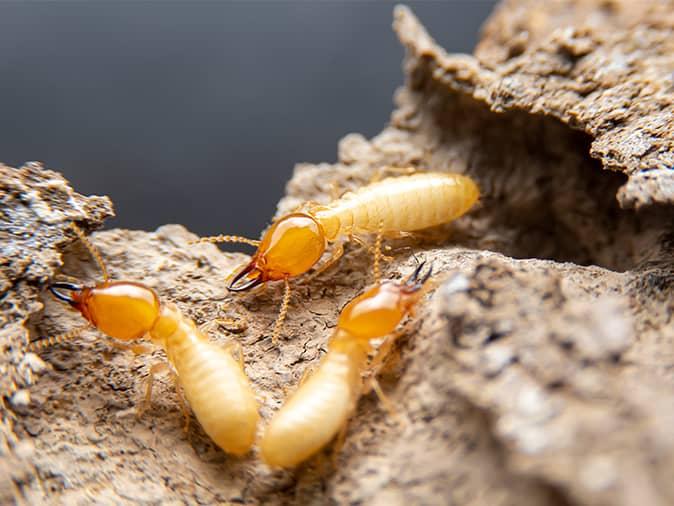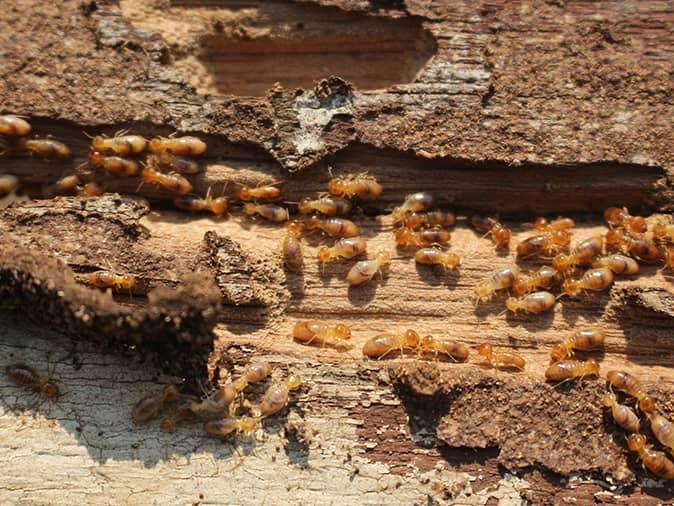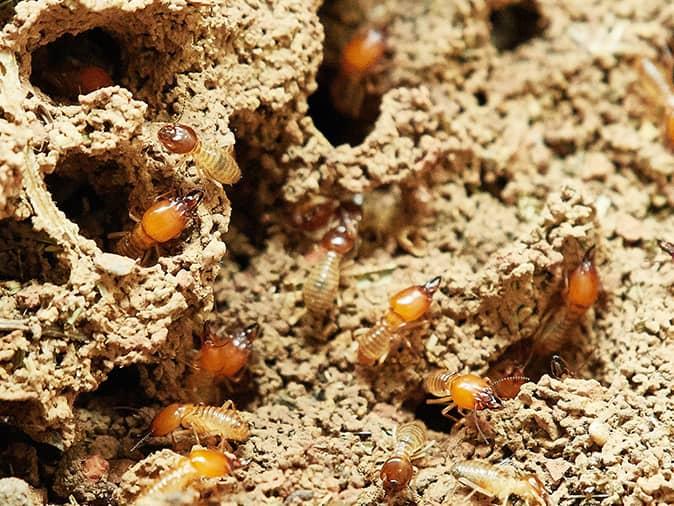Your home is your castle. But sadly it isn't made of stone like a real castle. If your home is like most homes in the United States, it is made of wood. And, while wood is a robust building material that can last for centuries, it is susceptible to damage from moisture and wood-destroying organisms. We're not talking about large wood-chewing pests such as the rat. We're talking about tiny wood-consuming insects that feed on the wood of your home for years, undetected--the kind of pest that can literally eat you out of house and home. Let's take a look.

The most destructive wood-destroying organism in the United States is the termite. But not all termites are created equal. Damage caused by drywood termites is estimated to be in the millions while subterranean termites cost U.S. property owners billions of dollars each and every year. This is primarily due to the secretive nature of subterranean termites. Drywood termites create exit holes and push their excrement out. These droppings, called frass, look like grains of pepper and are hard to miss when they accumulate on a sunlit window sill. When a property owner takes notice, it alerts them to the danger, and those termites are dealt with quickly. Subterranean termites keep their excrement inside their tunnels, making it more difficult to detect an infestation.
The nature of termite damage
Termite damage isn't instantaneous. It takes time for termites to eat away at a wooden structure. Therefore, secrecy is of the utmost importance. Both drywood and subterranean termites have their ways of being secretive. Here are a few characteristics that help termites avoid detection:
- The noises termites make are hard to hear. One of the ways termites communicate with each other is by tapping their heads against tunnel walls. This clicking noise is possible to hear if there is an active infestation, and you put your ear right up next to it but, even in an infested piece of timber, it is sometimes necessary to use a stethoscope to detect these noises. When detectable, they are described as a rustling sound rather than a clicking. When disturbed or threatened, this noise can increase to audible levels.
- Termites feed on the inside of wood. If termites attacked man-made structures from the outside and crawled around where we could see them, they would not be nearly as destructive. No property owner would tolerate the damage these insects inflict. The problem is that termite damage is done on the inside and is almost completely undetectable from the outside.
- Drywood termites attack a home from the air. They land on the outside of a house and climb right in. If they get into a location that is away from the common areas of a home, frass can go undetected. It is also possible for frass to get kicked out into a location that has sawdust or some other material in the location that can hide the presence of the frass. This can allow drywood termites to be just as destructive as subterranean termites.
The nature of termites

It can seem hard to fathom why termites are such a treat to our property. A worker termite isn't much larger than ¼ of an inch in length. Even with all the time in the world, wouldn't it be impossible for a creature this tiny to do any real damage to a home or business? Yes. If it was only that one little worker termite. The problem is that a termite colony can have thousands of individuals in it. And those individuals work as a collective whole to consume our property with no regard for how we feel about it. But they don't do it alone. They have accomplices. Inside the gut of a termite are hundreds of species of microbes like the protist Trichonympha agilis, which helps the termite to break down wood. Without these microbes, termites would not be able to hurt our property. This understanding of termite biology has led to advancements in termite control products that target termites and only termites. These products make it impossible for termites to process food and essentially causes them to starve to death. That is great for the environment and bad for termites. But, if a home doesn't have a termite defense product in place, those little wood-eating pests with their tiny little microbes can get in and do all the damage they want, for as long as they want. That leads us to our next point.
Termites don't sleep. It's true. These are extremely simple organisms. They don't require rest or sleep. While they will sometimes go into a dormant state when temperatures drop, it isn't for recuperation. It is simply because it is too cold to function. Termites don't need to recuperate. They can feed on wood and share food with other members of their colony nonstop, 24 hours a day, 365 days a year. That is bad news if these insects find their way into your property.
How to catch termite damage before it is too late
The more time termites are allowed to feed, the more damage they can do. If your property does not have termite protection, it is vital that you know how to recognize the signs of an infestation.
Mud Tubes
Subterranean termites are moisture pests. For this reason, they must use mud to protect themselves from being exposed to dry air or the sun. When they feed on a man-made structure, they often build mud tunnels up foundation walls to gain access. These tunnels, often call mud tubes or shelter tubes, are superhighways for termites to go in and out of the wood of your home, bringing food back to their nests. They build mud tubes inside sheetrocked walls, on interior walls, up the side of toilets and bathtubs, in attic spaces, and any other location where they are needed. If you see thin, mud-packed lines, in a pattern that looks like lightning or veins, be aware that subterranean termites make these.
Mud spots
Termites use mud to seal holes when worker termites accidentally chew a hole to the outside air. These tiny mud packed spots can give you a heads up that you have termites.
Swarmers
You are probably aware of what a swarmer looks like. These tiny black insects with their long white wings are well known because they are the most visible termites in a termite colony. In fact, they're the only termites you're likely to see. What you may not know is that swarmers are a sign of a mature infestation--not an infestation that is about to occur. There are two reasons for this. Termite swarmers do not swarm for long and swarmers do not travel far. If you're seeing swarmers inside or outside of your home, it is likely that those swarmers came from somewhere on your property, or somewhere near your property.
Bubbling paint
Subterranean termites consume wood right up to the paint. From the outside, a painted wall can look like it is completely sound, when all that is actually left is the paint itself. If you notice paint that is bubbling, tap the area with a screwdriver to see if the area beyond the paint is hollow. If you find wood that is dry and filled with channels, you have termites.
Cracking paint
When the wood behind paint is eaten away, the paint can sometimes have a cracked appearance. Chipping the paint away will help to quickly figure out whether or not termites are to blame.
Interior damage
Subterranean termites prefer soft wood but they can also feed on hardwood. Both of these termites can feed on the baseboards in a home. That makes baseboards a good place to examine for termite damage. If you look at your baseboards and there appears to be a honeycombing effect, or you place your finger firmly against a baseboard and it leaves an indent, it is likely that you have termites.
Hollow wood
If termites are feeding inside a piece of wood, it is sometimes possible to distinguish this by the sound the wood makes when you tap on it. If you tap a thick piece of wood and it sounds hollow or breaks apart, it is likely that you have termites eating away at it.
Sounds
As mentioned above, termites click their heads on tunnel walls to communicate with each other. This is usually done to inform other termites of danger. If you do something to startle termites, this rustling or clicking noise can be audible when you get up close to piece of infested timber.
Exterior damage
The damage done by subterranean termites can sometimes be seen in locations that have moisture. These locations will have water that is accumulating near a foundation wall, spots where the wood of a home touches the soil, shaded areas, and locations where wood is damp due to an obstructed or broken gutter. Under the cover of night, subterranean termites may come to the surface to feed in these moist locations.
Extensive damage
The last way you want to find out that you've had termites damaging your home for years is to start seeing walls bulge, ceilings begin to dip down, floors begin to sink, the corners of your porch to slope, and other structural damage that is sometimes mistaken for water damage. Termite damage can also cause doors and windows to stick or swing open freely. When these signs of a termite infestation are seen, you can be sure that termites have consumed thousands of trenches and tunnels inside your wall studs and support beams. This can lead to a warping of your home. Termite damage is sometimes so extensive that it causes a home to be completely totaled. That is years of investment and equity going right down the drain.
The insidious nature of termite behavior

Most of the time, the above signs of a termite infestation are subtle, so subtle, in fact, that active infestations have eluded detection from certified home inspectors. Subterranean termites can feed on a home for years without leaving a single sign. Here are a few ways they can do this:
- A subterranean termite worker can travel as far as the distance of a football field in search of food. Therefore, a nest does not have to be near your foundation walls. And, when a nest isn't near your home, it is less likely that termite swarmers will alert you to the danger. Those swarmers could go to another home or find a log in the forest to live inside, even while workers continue to feed on the wood of your house.
- Termites don't feed on one location. When a food source is found, many termite workers will continue to search for food while the one location is being eaten. This can lead to many small areas of damage, rather than one area. Then the overall damage ends up being extensive when it is finally discovered.
- While mud tubes are a clear sign of subterranean termite infestation, these tubes are often established in dark locations. This could be a crawl space under your home. It could be under your deck, patio, or porch. It may be behind a chimney that runs up the side of your home. These locations can be hard, or impossible, to get into.
- When subterranean termites find a portion of a home that directly touches the soil, they can eat their way up into the home without the need for creating mud tubes at all. This can make it nearly impossible to detect them under the right conditions.
How do you keep a silent, secretive, wood-destroying pest from damaging your home over time? The solution is to establish a barrier, and to maintain that barrier, for the life of your home. This should be done by a professional. Here are a few reasons why:
- A professional is educated in the detection of termites. When a trained and certified technician inspects your home for termite signs, they work with an extensive understanding of the habits and habitats of all termite species that are known to attack U.S. properties. They know where to look and what signs to look for. Since signs can be extremely subtle, it is always best to get a professional with specific knowledge of termite control to do an inspection.
- A professional has access to commercial termiticides that have a proven track record of arresting termite infestations, even as they begin. The number-one termite defense product in the U.S. is Termidor. When this product is applied to the foundation perimeter of a home, it doesn't just kill worker termites, it works to kill the nest that sent them. Termidor is undetectable to termites. When workers pass through it, they pick it up and share it with other termites in their colony. Slowly, it works its way back to the nest and eventually to the queen. When the queen dies, the termite colony dies with her. Without the queen, there is no reason for the termites to live. Every function of a colony is centered on the wellbeing of the queen, the production of eggs, and the creation of swarmers. Her death causes all of the termites to cease their activity and wait to die.
- Termiticide must be installed all the way around a structure to keep subterranean termites from tunneling underneath it. Professionals have commercial-grade equipment that gets the product where it needs to be, and applies it deep enough into the ground to ensure a successful barrier. This requires training. And professionals follow strict guidelines for how this process must be performed in order to safeguard property, human life, pets, and other living organisms.
- Chemicals don't last forever. A professional knows how to assess the continued effectiveness of the chemical barrier and ensure that termites are not allowed to damage the structure. This is accomplished by yearly inspections and application of more product as necessary.
Professional termite control services in New Jersey
If you live in our New Jersey service area, reach out to Arrow Pest Control to establish protection for your home. Termite damage is a horror no family should have to face. If you're like most homeowners in the U.S., your home is the largest investment you'll ever make. Protect your equity from the destructive impact of termites by having a Termidor barrier installed around your property. When termites come to feed, Termidor will immediately work to arrest the threat. It does this while you're sleeping and in between visits from your certified termite control professional.
When you invest in ongoing termite control from a trusted professional, you decide how much you're willing to allow termites to cost. Reach out to us today to request a free home estimate. Arrow Pest Control is an industry-leading pest controller with a track record of protecting property from the destructive influence of wood-destroying organisms. We'll help you manage the threat of termites and protect your equity from invasive and devastating termite damage.
Arrow Premier
If you’re looking for a program that protects your home and family from common household pests PLUS termites and other wood-destroying insects, we recommend Arrow Premier. With this program, you get quarterly pest control and a wood-destroying insect program in one package!
- Protects your home all year long.
- Consists of full interior and exterior inspections and treatments.
- Covers your entire property* including the attic, mailbox, play set, shed, and fence.
- Includes a certified termite inspection and ongoing termite control.
Pests targeted with Arrow’s Premier includes cockroaches, silverfish, spiders, earwigs, clover mites, millipedes, centipedes, crickets, ground beetles, boxelder bugs, ants (including carpenter ants, pharaoh ants and acrobatic), fleas (inside only), pillbugs, sow bugs, fruit flies, stored product pests, bees, wasps, hornets, carpenter bees (no higher than 10ft), mice, and rodents PLUS termites
*If you have a pool house that requires service, pricing would increase based upon the size of the structure.


Testimonials
Request Your FREE Estimate
Additional Services
Our solutions are designed for even your toughest pest problems.
Don’t let pests affect your quality of life, here's how we can help:
